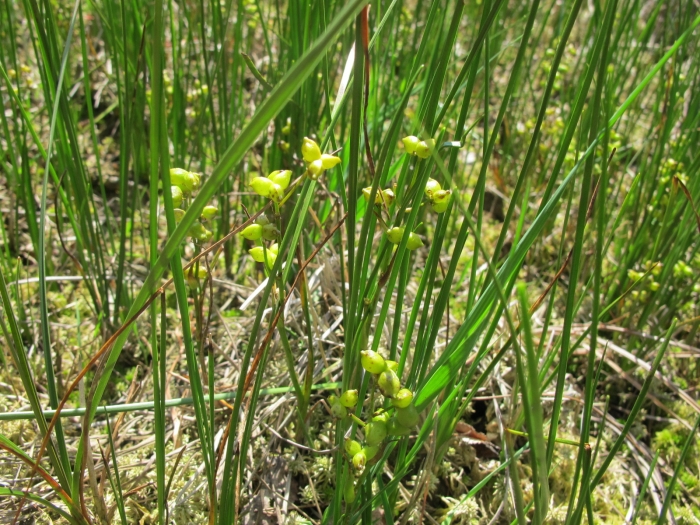Rannoch-Rush
(Scheuchzeria palustris)
Rannoch-Rush (Scheuchzeria palustris)
/
/

© Grzegorz Grzejszczak
CC BY-SA 4.0
Image By:
© Grzegorz Grzejszczak
Recorded By:
Copyright:
CC BY-SA 4.0
Copyright Notice:
Photo by: © Grzegorz Grzejszczak | License Type: CC BY-SA 4.0 | License URL: http://creativecommons.org/licenses/by-sa/4.0/ | Uploader: grzegorz_grzejszczak | Publisher: iNaturalist |

























Estimated Native Range
Summary
Scheuchzeria palustris, commonly known as Rannoch-rush, is an herbaceous perennial native to cool temperate regions of the Northern Hemisphere, specifically in boreal and subarctic zones. It is typically found in acidic, nutrient-poor wetlands, including Sphagnum peat bogs and marshes. This plant usually reaches a height of 4 to 16 inches (10 to 40 cm) and has narrow linear leaves that are grass-like in appearance. The greenish-yellow flowers, which are not particularly showy, consist of six tepals and bloom from June to August. The plant produces small, inconspicuous fruit capsules after flowering.
Rannoch-rush is valued for its ability to thrive in wet, peaty conditions, making it suitable for bog gardens and wetland restoration projects. It is also of interest for its rarity and specialized habitat requirements, contributing to the biodiversity of wetland ecosystems. In cultivation, it requires consistently moist or wet soil, acidic conditions, and full sun to part shade. While it is not commonly used in general landscaping, it can be an important component of native plant gardens and conservation areas. Scheuchzeria palustris is generally disease-free but can be difficult to establish due to its specific habitat needs. It is named after Swiss naturalist Johann Jakob Scheuchzer.CC BY-SA 4.0
Rannoch-rush is valued for its ability to thrive in wet, peaty conditions, making it suitable for bog gardens and wetland restoration projects. It is also of interest for its rarity and specialized habitat requirements, contributing to the biodiversity of wetland ecosystems. In cultivation, it requires consistently moist or wet soil, acidic conditions, and full sun to part shade. While it is not commonly used in general landscaping, it can be an important component of native plant gardens and conservation areas. Scheuchzeria palustris is generally disease-free but can be difficult to establish due to its specific habitat needs. It is named after Swiss naturalist Johann Jakob Scheuchzer.CC BY-SA 4.0
Plant Description
- Plant Type: Grass
- Height: 0.25-0.6 feet
- Width: 0.25-1.25 feet
- Growth Rate: Slow
- Flower Color: N/A
- Flowering Season: Spring, Summer
- Leaf Retention: Deciduous
Growth Requirements
- Sun: Full Sun, Part Shade
- Water: High, Aquatic
- Drainage: Standing
Common Uses
Low Maintenance, Water Garden
Natural Habitat
Cool temperate regions of the Northern Hemisphere, specifically in boreal and subarctic zones, acidic, nutrient-poor wetlands, including Sphagnum peat bogs and marshes
Other Names
Common Names: 장지채, Scheuchzer’s Cotton-grass
Scientific Names: , Scheuchzeria palustris, Papillaria palustris, Scheuchzeria americana, Scheuchzeria asiatica, Scheuchzeria generalis, Scheuchzeria palustris subsp. americana, Scheuchzeria palustris var. americana, Scheuchzeria palustris var. palustris, Scheuchzeria paniculata,
GBIF Accepted Name: